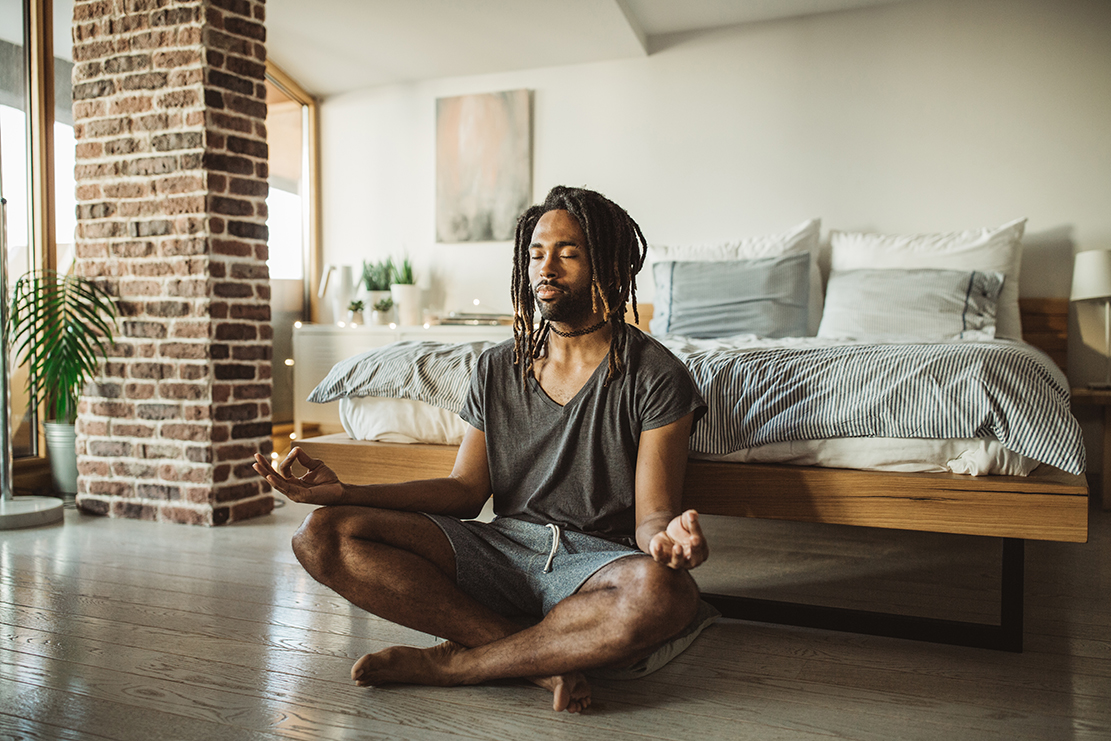As we know, meditation practice produces numerous benefits for mental health: it brings deep inner peace, mental clarity, resilience, better ability to process difficult emotions, better sleep and so much more. It can be a wonderful tool in dealing with depression, grief, PTSD, anxiety, and can help you heal the very root cause of these disorders. And science confirms that meditation can literally rebuild your brain into its healthiest, most powerful version.
But when it comes to trying out meditation, many of us find ourselves in a loss. It can feel slightly scary and confusing because of all the messages out there of what meditation “should be” or what it looks like. Today, we will counter the biggest misconceptions about meditation and outline some of the tips that we believe can help you start meditating with ease and lots of joy.
1. Start small
When you are only starting to play with meditation, don’t expect yourself to sit still for 30 minutes. Just like with any practice, you build and get better gradually, and meditation is no exception. We suggest starting with only 5 minutes of meditation, gradually building to 10, and from there you might want to increase the duration as it feels so good. And if 5 minutes feel like an eternity, try starting with 3. The main point is to ease into the practice instead of giving yourself another to-do that feels like a chore.
2. Don’t expect to stop thinking
Lots of people think that the whole point of meditation is to sit still without any thoughts for a set period of time. This could not be further from the truth. When you meditate for a bit, you will see that the absence of thought is a direct result of the meditation experience, but not its sole point. We suggest observing your thoughts, allowing them to “speak out” as much as they need to, and let them go when they are done. Much like you would listen to a small child when they have so many emotions and have to much to say. When they are done speaking out, they come back to their normal calm centered self. Another example of dealing with intrusive thoughts during meditation is observing them float by, just like clouds in the sky. They come into the view, drift by and disappear. You do not have to engage with any of these thoughts, just let them be present for as long as they need to, and they will drift away on their own. The mind will become clear, and after that, the really good part of meditation will begin.
3. Find/create a comfortable spot
What image do you have in mind when you hear the word “meditation”? Is it sitting cross-legged on the floor with your hands in prayer or open on your knees? Or is it standing in the tree pose on the mountain? Even though those are some of the most popular “images” of meditation, they will not work for you unless you find them enjoyable and are able to fully relax. We recommend finding a spot in your house where you will feel cozy, protected, safe and comfortable. It can be your bed, your closet, your couch, your back yard, your office chair. Any place works, as long as you are able to relax there and feel like you will not be interrupted. After you pick your spot, think a little about the details. Would you like some bright sun, darkness, or maybe some candles? Create yourself the atmosphere of comfort and love, and you will multiply your chances of enjoying your practice and sticking with it.
4. Pick your ambiance
Would you like to meditate in silence or do you like slow relaxing music? Maybe you prefer the sounds of breaking waves or rain? Or would you rather be guided through your meditation experience? All of this is up to you, and we suggest you play with your sounds and music until you find something you LOVE. Some day it might be your favorite meditation track, and another day you might prefer silence or meditating in your backyard listening to birds and background noises. Pick what feels the most relaxing and that helps you leave your life for a bit and be with yourself in complete peace.
5. Find a way that feels good to you
This is probably one of the main tips we would like to convey to you today and all the other tips fall under this one. The meditation practice you are establishing is yours and yours only. It must be crafted for you, your unique preferences and lifestyle. And with so many ways to meditate, we are sure you will be able to find something that fits you. The whole practice is about you and your way back to self without any distractions. So we suggest tailoring your daily practice to your most extravagant wishes.
6. Remember, there is no wrong way to meditate
There is no wrong way to go within. There is no wrong way to focus on yourself. With meditation, we suggest you drop the “rules” and zero in on being you and how that feels. Let yourself have thoughts and emotions, and let them go when they are finished.
7. Drop all expectations
We suggest coming to your meditation pillow (or bed, or couch) without any expectations. Let your experience be what it needs to be for you at that moment. This way, you will have more freedom to mold your practice around yourself and your unique wishes and preferences. With no expectations, we allow the deepest healing to happen.
8. Forget all you think you know about meditation
All those pre-conceived notions about meditation – we suggest leaving them beyond your meditation space as well. The more freedom from “how it needs to be” or “what it needs to do” meditation practice has, the more room it has to actually help you and fast.
9. Noise-canceling headphones can help
If you find it hard to disassociate from all the sensory input around you, noise-canceling headphones might be able to help. Moreover, if you find a great meditation track that reflects the way you aspire to feel, you can be led by that music into that feeling without any distractions with the help of good pair of headphones.
10. Commit to a period of time
When I started meditating, the hardest thing about it was day 2 – when I had to sit myself back down after I hated doing it on day 1. And my life would have never been transformed by this powerful practice, had I not committed to 7 days of meditation. We are all different, so we suggest you pick a length of time that suits you best and stick with it religiously. If you give it your honest effort and it does not produce good results, you never have to do it again. But for now, pick your time frame and commit to it without any compromise.
11. Enjoy your time with yourself
In the last tip, we want to remind you that this practice is all about you, and will generate as much joy for you, as you allow. You can treat meditation as a chore, or you can look at it as a special time in the day when you get to be in the space where nobody wants anything from you, where no one is bothering you, and you get to just be. Enjoy it as much as you can, and let us know how it goes in the comments below.
If you find any roadblocks or challenges, feel free to reach out to us in the comments or through our social media, and we will help you with all the knowledge, experience and resources we have gathered so far.
Love,
– The Alleviant Team






